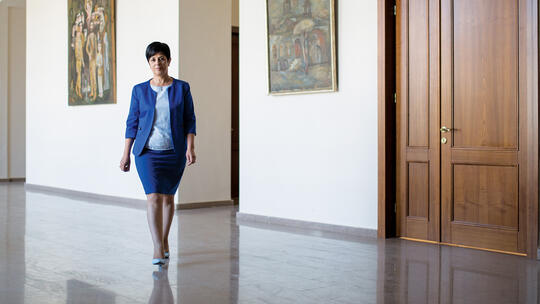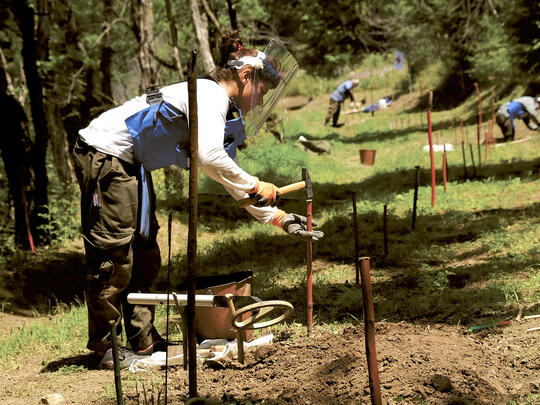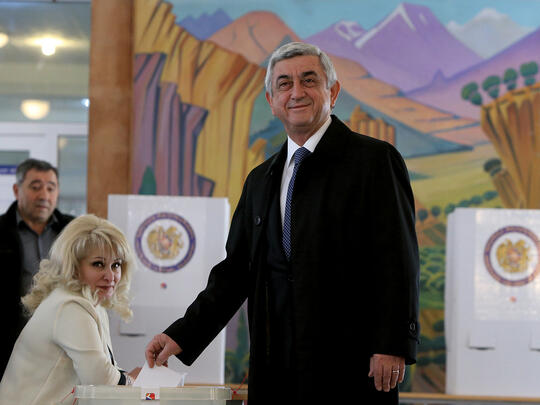With the outbreak of war in the early 1990s in the Republic of Artsakh, the historically shaped perception of women in traditional Armenian communities—mainly as mothers and homemakers—collapsed for good. Some women took up arms to stand alongside men during the war while others, burdened by economic hardship, took on the responsibility to provide for their families on their own.
In the aftermath of the war, restoration and development created new opportunities for women to advance in their careers. The egalitarian approach to the labor market, inherited from the Soviet Union, significantly benefitted women. According to the Republic of Artsakh’s National Statistical Service, by 2015, 28,000 women—roughly 87 percent of working-age females—were employed. Over a 10-year period, the number of female senior executives jumped by 327 percent, amounting to 2,540 people, while the rate of women in senior positions in state and local government; judicial and legislative bodies; private companies; and non-governmental organizations increased by 63 percent, accounting for more than a third of the total number of women in the workforce in the Republic of Artsakh.
Tevan Poghosyan, president of the International Center for Human Development in Yerevan, and former director of the Public Affairs Office of the Nagorno-Karabakh Republic in the United States, considers the rise of female employment in the region as a predictable outcome of developments in the republic and around the world. He emphasized that women in Artsakh are active, educated and empowered, with the necessary skills to hold executive positions.
“Artsakh is now responsible for its own security and men are mainly working in defense-related jobs. This creates opportunities for women who are more willing to take office jobs and subsequently are being promoted to executive positions,” Poghosyan says.
Over the past several years, a growing number of female public figures have not just reached the highest levels in government, business and the arts, but excelled in the process. Their accomplishments are remarkable on their own, but even more so given how difficult it is to make inroads in industries traditionally dominated by men. They have made a positive impact not only in their respective spheres of influence but in doing so redefined what it means to be a successful woman in Artsakh.
Narine Aghabalyan, Armine Aleksanyan and Lira Kocharyan are examples of this emerging class of well-educated and highly-talented women. With their professionalism, poise and perspective, they are changing the way women are perceived in a traditionally patriarchal culture, serving as role models and empowering other women. Devoted and strong-willed, they are confident about the future of Artsakh, not mired in the past nor intimidated by the challenges created by a protracted conflict that continues to threaten the region’s stability and growth.
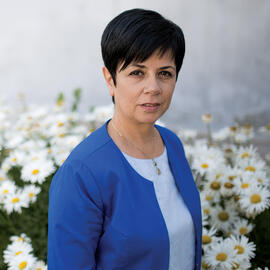
Narine Aghabalyan
Changing the cultural landscape
Artsakh’s vibrant and dynamic cultural life is thriving. Concerts, exhibitions and festivals regularly held in both cities and villages light up life in the republic. Minister of Culture and Youth Affairs Narine Aghabalyan, one of two female members in the government, has spearheaded the development of arts and culture in the region for the past eight years. Humble and straightforward, she does not take credit for the change in the republic’s cultural landscape, insisting she is simply building upon the work of her predecessors. She attributes this transformation to the shift in the country’s cultural policy on a strategic level, which mirrors the new, forward-looking agenda for long-term sustainable development.
“After the war, cultural policy reflected the needs of recovery and targeted single projects,” Aghabalyan says. “Now we are pursuing a policy aimed at the sustainable development of culture to create a more lasting impact.” Aghabalyan aims to build and enhance local capacities with the establishment of art schools, particularly in rural areas, and proportional development of arts that have not traditionally been popular. She says this is even more important than major events with renowned Armenian and foreign artists that shine an international spotlight on the Republic of Artsakh. Preserving Artsakh’s cultural identity and making it more recognizable in the world are two other top priorities. “Our identity was altered when Artsakh was part of Soviet Azerbaijan. We need to help people return to their roots and traditions by reviving our ethnic music and the arts and by making culture distinct and recognizable.”
In 2012, a decision to move the ministry from Stepanakert to the historic city of Shushi, a well-known cultural hub in the Caucasus, played a critical role in helping to restore Artsakh’s rich cultural identity. “Making Shushi the cultural center was the only way to revive the city,” Aghabalyan says with pride. “I can firmly say that Shushi is the cultural capital of Artsakh.” The move transformed the city—which until 2012 had visible echoes of the war. Now it is a vibrant and interesting city not only known for its architecture, but also for arts and culture that attracts a lot of visitors.
Aghabalyan points to the Artsakh State Chamber Orchestra, established with the support of AGBU, as an example of the quality and diversity in the republic’s cultural life. She hopes to establish a symphonic orchestra, comprised of local musicians.
An experienced and well-known journalist, Aghabalyan led her own media company before accepting her ministerial position in 2009. Soon she became one of the most reputable female public figures in government, devoting most of her time to work.
“People who are in politics or hold senior positions should be ready to have less personal time,” she admits, stressing that her job requires a 24-hour commitment. “Culture is an exceptional field that allows me to combine work and leisure. Almost every day, I attend interesting cultural events not only to enjoy, but also to understand what to do next,” she says. A war widow who lost her husband at the age of 23, Aghabalyan is grateful to her family for their support and understanding. She strives to spend every spare minute with her family and enjoy the company of her grandchild.
She credits her success to her ability to lead and take initiative to go above and beyond what is expected. “I have never been satisfied with my accomplishments at work. I have always strived to achieve more,” she said, calling on younger women to believe in themselves and work hard on self-development and furthering their education.
I have always tried to take jobs that I like. And I have never been satisfied with my accomplishments at work. I have always strived to achieve more.

Lira Kocharyan
Creating opportunities for young people
Lira Kocharyan possesses a unique gift for recognizing talent and nurturing success. While she is usually out of the public eye, Kocharyan is responsible for developing and managing the careers of many child performers and young artists. “Some people have a talent for composing, acting or dancing. I have a talent for recognizing gifted children and transforming them into professional performers,” Kocharyan says. A classical pianist and a self-trained art director and producer, she not only creates opportunities for young singers but, by developing their talent, helps raise the profile of the cultural heritage of Artsakh both locally and abroad.
Kocharyan recruits children and young singers for the Voices of Artsakh ensemble, which she established in 2004. At the time, the idea was considered by many to be too risky and non-sustainable—an unnecessary luxury for a small country trapped in the urgency of post-war recovery. With a firm belief in the transformative power of music, however, Kocharyan began training children and young singers, improving their artistic skills and exposure through international competitions. She admits that her experience at the Stepanakert Music College after Sayat-Nova, first as a music teacher and later as director, was critical in advancing the ensemble. The group relied on benefactors for financial support until it began to receive public funding in 2014. “For professional singers, it is hard to make a living in Artsakh, as the market is very small,” Kocharyan says, stressing the importance of governmental support.
Now the ensemble, with a rotating staff of up to 40 singers ranging in age from as young as four to thirty-one, is popular throughout Artsakh and Armenia. Several of its soloists regularly represent Armenia in popular international song contests, including Junior Eurovision and New Wave, a song competition well known in Russia and neighboring countries. The ensemble gained more fame with Vladimir Arzumanyan’s victory at Junior Eurovision in 2010. Another popular singer, Misha, who performed during the Aurora Prize 2017 Ceremony, was chosen to represent Armenia at this year’s Junior Eurovision.

To date, performers from the region have not been allowed to represent Artsakh in international contests, with organizers fearing a furious reaction from Azerbaijan. Instead, they represent Armenia to avoid confrontation. Unfortunately, Azerbaijan’s protests limit the ensemble’s tours abroad. “Often, concert organizers in foreign countries do not even advertise our performances to avoid possible repercussions from Azerbaijan.”
The ensemble’s repertoire is a fusion of folk, jazz, rock and popular music often staged in the style of Broadway musicals that reflects Kocharyan’s artistic vision and taste. Amid training and production, she also assembles folk songs in the local dialect and gives them a second life by mixing old tunes with modern rhythms. Many not-widely-known local folk songs, she said, might easily disappear in the future if they are not preserved. “There is no research on Artsakh’s sub-culture, especially its musical heritage,” said Kocharyan. “We are trying to revive these ethnic songs and give them a modern touch. Although we know that our work might be criticized, we need our youth to learn about and become interested in their ethnic heritage,” she adds.

A lively and energetic woman, she possesses a strong and determined character, combined with an entrepreneurial spirit and creativity, which helped convince others to believe in the importance of her work and its impact on Artsakh’s youth. Proud of the success of the Voices of Artsakh, Kocharyan admits that her gender has not created many obstacles throughout her career, but it took her longer to make people believe in her work. “Both my parents held senior managerial positions and they encouraged me to study and focus on my career. Many well-educated and intellectual families did so,” she says. “Women in Artsakh are independent, active and willing to take risks. Sometimes they are even more active than men.”
Women in Artsakh are independent, active and willing to take risks. Sometimes they are even more active than men.
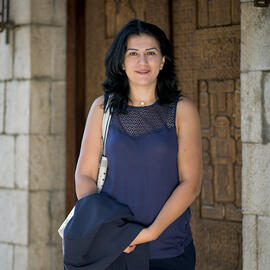
Armine Aleksanyan
Advocate for Artsakh
Consider for a moment what it takes to be a high-ranking diplomat, then add to that the challenge of having to represent a non-recognized state on the international stage, one whose existence is the subject of decades-long conflict and debate. As the Republic of Artsakh’s deputy foreign minister, Armine Aleksanyan has embraced the challenge. She understands the constraints her position entails but at the same time is constantly seeking creative solutions to bypass its limitations.
Recognized by only three non-UN member states—South Ossetia, Abkhazia and Transnistria—the Republic of Artsakh depends heavily on its representatives in seven countries on four continents to make its voice heard. In this context it is all the more important to ensure that the Republic of Artsakh’s position is duly represented throughout international organizations in which it cannot participate.
At the Ministry of Foreign Affairs, Aleksanyan oversees the divisions of International Organizations and Humanitarian Co-operation, as well as Media and Public Relations, which includes assisting foreign journalists. Born in Artsakh’s Martouni region, she studied foreign languages at the Artsakh State University and continued her education in the United Kingdom, receiving a master’s of arts in diplomatic studies from the Diplomatic Academy of London at the University of Westminster in 1999. She got her start at the ministry in 2000, and was promoted to her current position in 2014. In her current senior role, she adds an essential female perspective to the decision-making process while at the same time prioritizing the dedication and professionalism of all of the staff at the Ministry of Foreign Affairs.
As a working woman, Aleksanyan admits it can be a challenge to maintain a healthy work-life balance and have enough time and energy for her family. “Every society has certain stereotypes. There are certain cultural and social expectations of women and men in every society.” Nevertheless, Aleksanyan has never allowed those stereotypes to affect her professionally—she loves her job and has never stopped learning. “I am convinced that women nowadays are more empowered to make an impact anywhere they choose to work, be it in politics or any other sphere.”
I am convinced that women nowadays are more empowered to make an impact anywhere they choose to work, be it politics or any other sphere.
Aleksanyan emphasizes the importance of receiving a high-quality education abroad. “Young people striving to develop a career in diplomacy should know how to communicate with foreigners and not be limited to the outlook formed by their upbringing in Artsakh,” Aleksanyan says. Unfortunately, the isolated status of Artsakh contributes to more and more young people being deprived of the opportunity to acquire an education in the best universities around the world. Aleksanyan is convinced that the unrecognized status of the country should not become a hindrance for its people, preventing them from fully exercizing their rights. It is a critical message that the Ministry of Foreign Affairs seeks to convey both at home and abroad: increasing the number of educated citizens able to contribute to a more protected system of human rights and democratic freedoms, will better serve peace and stability in the region.

In the capital of Stepanakert, the renowned statue of a couple adorned in traditional attire entitled We Are Our Mountains, proudly overlooks the city, symbolic of Artsakh’s centuries-old history and culture. As its people today strive to preserve their heritage and identity while at the same time seek to transform Artsakh into a modern, independent, and internationally-recognized nation, the work of these exceptional women and many others will leave a lasting legacy and help shape the future of Artsakh.
Banner photo by Areg Balayan

